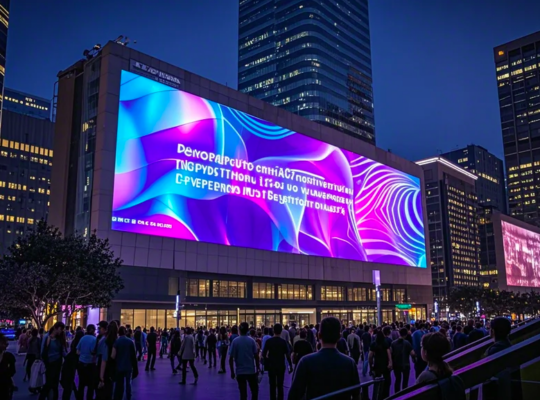Table of Contents
ToggleLED video walls are a powerful display solution that combines multiple LED panels to create a larger, visually striking screen. The walls serve a variety of purposes, from digital signage and advertising to live events and command centers. To understand how LED video walls work, let’s explore their core components, the technology behind them, and the advantages they bring.

What is an LED Video Wall?
An LED video wall is a large-scale display composed of interconnected LED panels, forming a seamless, high-resolution screen that can show images, videos, and other digital content. Unlike traditional projectors or LCD screens, LED video walls provide brighter images, higher contrast ratios, and flexible scalability. LED display technology enables each panel to deliver vivid colors and crisp visuals, even in bright environments, making it ideal for outdoor and indoor installations.
Core Technology Behind LED Video Walls
The key to LED video wall technology lies in light-emitting diodes (LEDs). Each LED display panel consists of tiny LEDs that emit light when an electric current passes through them. There are two types of LEDs used in video walls: surface-mounted device (SMD) LEDs and chip-on-board (COB) LEDs. SMD LEDs are more common, as they allow for compact designs and higher pixel density. Meanwhile, COB LEDs provide a more rugged option for high-traffic areas and outdoor displays.
LED video walls work by connecting multiple panels through a central processor, also known as a video wall controller. This controller splits the content across all the panels, ensuring that each section displays its assigned part of the image or video. The resulting image is cohesive and fluid, appearing as one large screen rather than individual panels. Furthermore, the controller manages color calibration, brightness, and contrast settings to optimize the visual quality across the LED video wall.
Key Technologies Used in LED Video Walls
- Pixel Pitch: Pixel pitch refers to the distance between the center of two adjacent pixels on an LED display. A smaller pixel pitch results in higher resolution and is ideal for close-up viewing. LED video walls typically offer pixel pitches ranging from 0.9mm to 10mm, with lower pitches for indoor displays and higher ones for outdoor setups.
- Brightness Control: LED video walls have high brightness levels, often reaching up to 10,000 nits (candela per square meter), making them suitable for environments with strong ambient light. Advanced brightness control features help the LED display adjust automatically based on external lighting conditions, ensuring optimal visibility at all times.
- High Refresh Rates: High refresh rates (often exceeding 3,000Hz) ensure smooth transitions and flicker-free visuals, even for fast-moving content. This feature is especially critical in broadcasting and live event applications, where visual clarity is paramount.
- Color Calibration: Uniformity in color and brightness across the entire LED video wall is essential for image consistency. Automated calibration tools are often used to balance color and brightness, ensuring a seamless display experience that maintains image fidelity over time.
Advantages of LED Video Walls
The benefits of LED video walls are numerous, making them a popular choice across industries. Here are a few key advantages:
- Superior Visual Quality: LED video walls deliver vibrant colors and deep contrasts, with many supporting 4K or even 8K resolution. The high-definition image quality ensures that viewers get a sharp and immersive visual experience.
- Scalability: Unlike single large screens, LED video walls can be customized to any size and aspect ratio. By adding or removing panels, users can adjust the screen dimensions based on their specific requirements.
- Energy Efficiency: LEDs consume less energy than many traditional display options, contributing to cost savings and environmental benefits. LED video walls are designed for energy efficiency, making them a sustainable choice for long-term installations.
- Reliability and Longevity: With a typical lifespan of over 100,000 hours, LED video walls are built for endurance. They also offer superior durability, even in demanding environments, making them an ideal choice for both indoor and outdoor applications.
- Enhanced Flexibility: LED video walls are versatile and can be configured to form curves, wrap around corners, or even create 3D effects. This flexibility in design makes them suitable for creative installations in venues, museums, or retail spaces.
Applications of LED Video Walls
Due to their versatility and robust technology, LED video walls have found widespread applications:
- Control Rooms: In environments that require real-time data visualization, such as traffic management centers or emergency operation centers, LED video walls are essential for displaying critical information at a large scale.
- Retail and Advertising: LED video walls attract customers with dynamic and interactive content, allowing retailers to create immersive shopping experiences and engaging advertisements.
- Corporate Settings: Businesses use LED video walls for digital signage, presentations, and video conferencing. The large displays enhance collaboration and communication in corporate environments.
- Entertainment and Sports Venues: From live concerts to sports arenas, LED video walls provide audiences with clear, high-quality views, amplifying the experience for everyone in attendance.
Conclusion
LED video walls are a sophisticated, visually powerful display technology made possible by advanced LED displays, pixel pitch optimization, color calibration, and brightness control. The result is a vibrant, durable, and customizable solution that meets a wide range of applications and requirements. As LED technology continues to evolve, LED video walls are becoming more efficient and accessible, bringing new possibilities to industries worldwide. Whether for advertising, entertainment, or critical operations, LED video walls offer a captivating display solution that meets today’s demand for quality and innovation.
0
